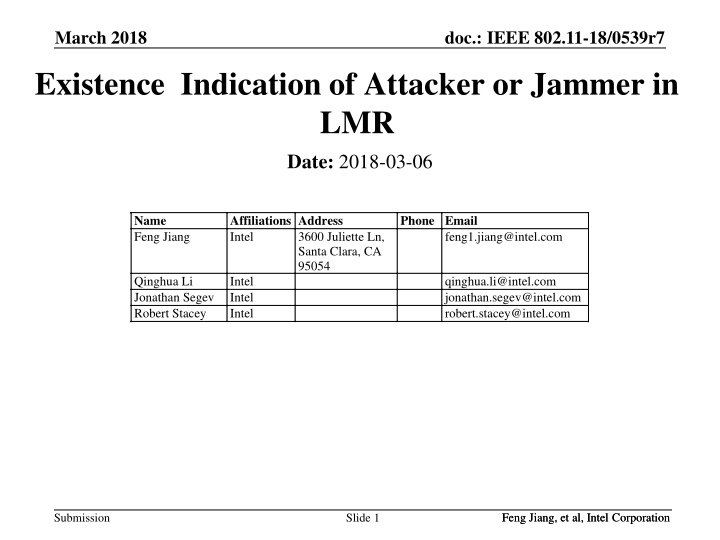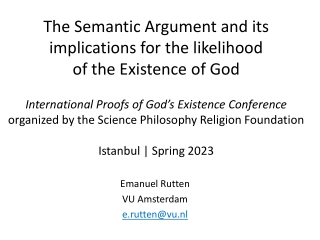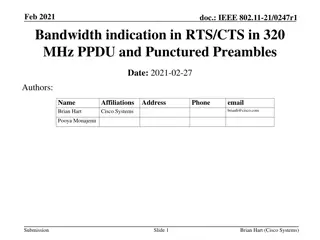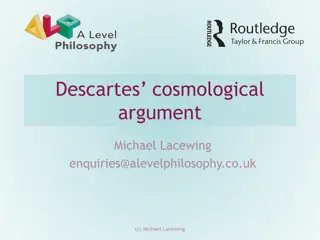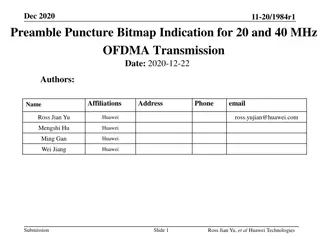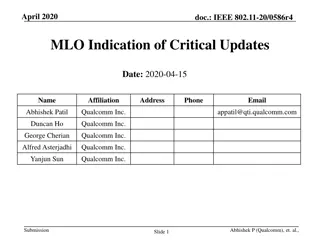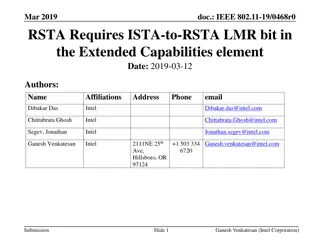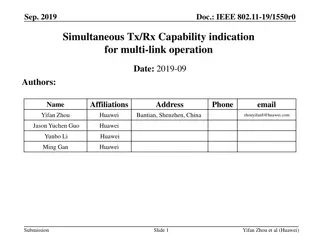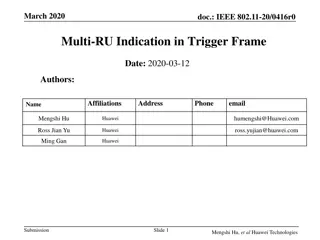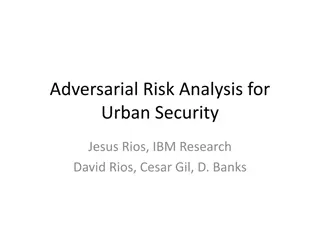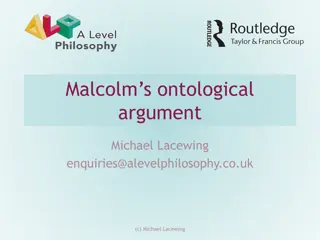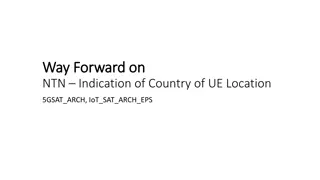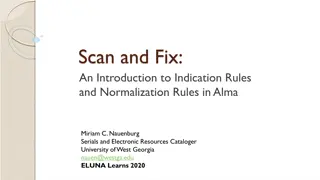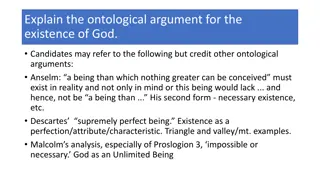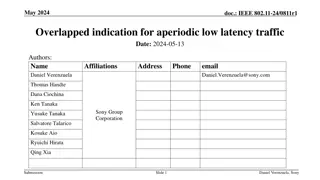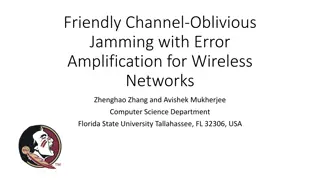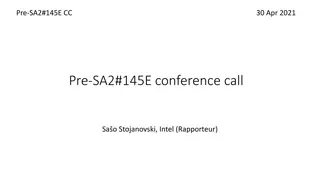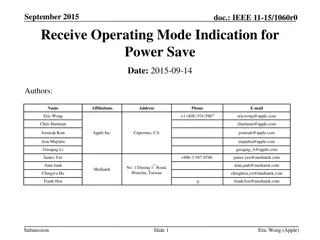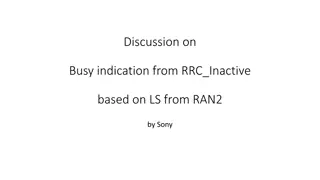Existence Indication of Attacker or Jammer in LMR
This document discusses the detection and notification of attackers or jammers in wireless communication systems, proposing a parameter field in the LMR frame for signaling their presence. Methods for interference detection, ToA estimation accuracy, and secure wireless ranging are explored, providing insights into immediate and delayed indication scenarios. Additionally, support for 80+80 and 160MHz bandwidths in 11ax and 11ac standards is highlighted.
Download Presentation

Please find below an Image/Link to download the presentation.
The content on the website is provided AS IS for your information and personal use only. It may not be sold, licensed, or shared on other websites without obtaining consent from the author.If you encounter any issues during the download, it is possible that the publisher has removed the file from their server.
You are allowed to download the files provided on this website for personal or commercial use, subject to the condition that they are used lawfully. All files are the property of their respective owners.
The content on the website is provided AS IS for your information and personal use only. It may not be sold, licensed, or shared on other websites without obtaining consent from the author.
E N D
Presentation Transcript
March 2018 doc.: IEEE 802.11-18/0539r7 Existence Indication of Attacker or Jammer in LMR Date: 2018-03-06 Name Feng Jiang Affiliations Address Intel Phone Email 3600 Juliette Ln, Santa Clara, CA 95054 feng1.jiang@intel.com Qinghua Li Jonathan Segev Robert Stacey Intel Intel Intel qinghua.li@intel.com jonathan.segev@intel.com robert.stacey@intel.com Feng Jiang, et al, Intel Corporation Feng Jiang, et al, Intel Corporation Submission Slide 1
March 2018 doc.: IEEE 802.11-18/0539r7 Introduction In 11az PHY security mode, methods are proposed for interference detection The repeated LTF symbols for consistency check Energy detector for detecting replay attacker Attacker or jammer significantly degrade the ToA estimation accuracy, and the polluted ToA estimations should be discarded. For security protection, the wireless ranging may be disabled. When initiator or responder detects the attacker or jammer, it s necessary for the other side to be notified, such that both sides can behave properly. In this submission, we propose to define a parameter field in the LMR frame to indicate the existence of the attacker or jammer. Feng Jiang, et al, Intel Corporation Feng Jiang, et al, Intel Corporation Submission 2
March 2018 doc.: IEEE 802.11-18/0539r7 Definition of the New Indication Field in LMR Option 1: Add a new information field in the LMR Option 2: Use reserved bits in the ToA error field The Bit B5 can be used for interference indication Only valid for the security mode Feng Jiang, et al, Intel Corporation Feng Jiang, et al, Intel Corporation Submission 3
March 2018 doc.: IEEE 802.11-18/0539r7 Usage Example for Immediate LMR When attacker or jammer is detected, the responder sets the existence indication field in the immediate LMR to notify the initiator. Similar rule applied to bidirectional LMR and MU measurement sequence. Feng Jiang, et al, Intel Corporation Feng Jiang, et al, Intel Corporation Submission 4
March 2018 doc.: IEEE 802.11-18/0539r7 Usage Example for Delayed LMR For delayed LMR, if attacker or jammer is detected, the responder will set the existence indication of attacker or jammer for the previous round measurement. Similar rule applied to bidirectional LMR and MU measurement sequence. Feng Jiang, et al, Intel Corporation Feng Jiang, et al, Intel Corporation Submission 5
March 2018 doc.: IEEE 802.11-18/0539r7 80+80 and 160MHz Bandwidths Support of 80+80 and 160MHz bandwidths Optional feature in11ax and 11ac CBW160 or CBW80+80 may be generated using two separate RF LOs VHT- or HE-LTF sequence is only defined for 80MHz band o Upper and lower 80MHz bands use the same LTF sequence (11ac) o Or with sign flip for some segments of the sequence (11ax) The upper and lower 80MHz bands can be processed separately in digital domain Feng Jiang, et al, Intel Corporation Feng Jiang, et al, Intel Corporation Submission 6
March 2018 doc.: IEEE 802.11-18/0539r7 80+80 and 160MHz Bandwidths in 11az 11az uses random HE-LTF sequence for security protection Using same HE-LTF sequence for upper and lower 80MHz segments Aligns with legacy design Same security protection level as single 80MHz band A sign flip may be applied to the LTF sequences on upper and lower 80MHz segments for PAPR reduction Feng Jiang, et al, Intel Corporation Feng Jiang, et al, Intel Corporation Submission 7
March 2018 doc.: IEEE 802.11-18/0539r7 LMR for 80+80 and 160MHz Bandwidths Diversity gain across upper and lower 80MHz segments If measurement in one 80MHz segment is invalid, the measurement on the other 80MHz segment can still be used for RTT calculation If measurements on both 80MHz bands are valid, the RTT results can be averaged for improving accuracy To exploit the diversity gain, for 80+80 and 160MHz bands LMR includes single ToA and ToD field for both 80MHz segments The ToD on the upper and lower 80MHz segments should be the same Invalid bit indicates whether the ToA and ToD are valid or not Feng Jiang, et al, Intel Corporation Feng Jiang, et al, Intel Corporation Submission 8
March 2018 doc.: IEEE 802.11-18/0539r7 Straw Poll #1 For secured TB and NTB ranging on 80+80 and 160MHz bandwidths, do you support Using same LTF sequence for upper and lower 80MHz segments Y: 13 N:0 Abstain: 2 Feng Jiang, et al, Intel Corporation Feng Jiang, et al, Intel Corporation Submission 9
March 2018 doc.: IEEE 802.11-18/0539r7 Motion #1 For secured ranging on 80+80 and 160MHz bandwidths, we agree Using same LTF sequence for upper and lower 80MHz segments Moved: Feng Jiang Second: Qinghua Li Y: 12 N: 0 Abstain:2 Feng Jiang, et al, Intel Corporation Feng Jiang, et al, Intel Corporation Submission 10
